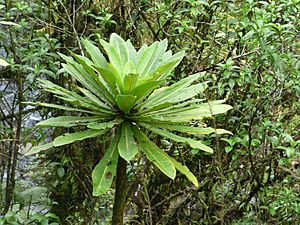Wetforest cyanea facts for kids
Quick facts for kids Wetforest cyanea |
|
|---|---|
 |
|
| Conservation status | |
| Scientific classification | |
| Genus: |
Cyanea
|
| Species: |
hamatiflora
|
The Cyanea hamatiflora is a very rare flowering plant. It belongs to the bellflower family. People often call it the wetforest cyanea. In the Hawaiian language, it is known as haha.
This special plant only grows in Hawaii. You can find it on the islands of Maui and Hawaii. Sadly, there are probably fewer than 250 of these plants left in the whole world. Because it is so rare, the government has listed it as an endangered species. This means it is in danger of disappearing forever.
About the Wetforest Cyanea
The wetforest cyanea is a type of Hawaiian lobelioid. These are unique plants found only in Hawaii. This plant grows as a shrub in rainforests. It often looks a bit like a small palm tree.
Different Kinds of Wetforest Cyanea
There are two main types, or subspecies, of the wetforest cyanea:
- ssp. hamatiflora: This type is found on Maui. It is a bit more common than the other type, but there are still fewer than 250 plants left. Its numbers are shrinking quickly, losing at least 25% of its population each generation.
- ssp. carlsonii: This type is much rarer. Today, there might be only 3 or 4 of these plants left. Other groups of these plants and any young plants that were put back into nature are thought to be gone.
Why Is It Endangered?
Many things threaten the wetforest cyanea and make it hard for it to survive.
- Habitat Loss: The places where these plants grow are being damaged.
- Animals: Wild animals like feral pigs, goats, cattle, rats, and slugs eat or damage the plants.
- Invasive Plants: Other plants that are not native to Hawaii grow too much and take over the space. These include plants like selfheal, Kahili ginger, and velvet tree. They compete with the native cyanea for sunlight and nutrients.
- Natural Events: Things like landslides can also harm the plants.
- Insects: There is also an unknown insect that damages the plant's fruit, which means fewer new plants can grow.


